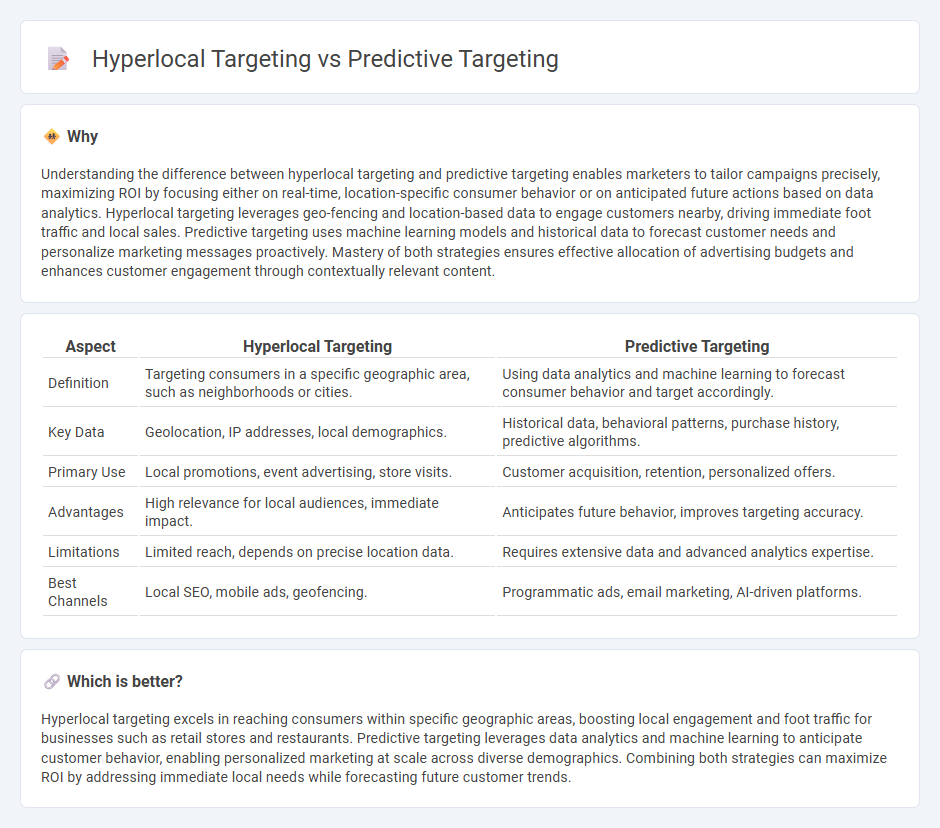
Hyperlocal targeting focuses on delivering marketing messages to consumers within a very specific geographic area, leveraging location data for personalized offers and local engagement. Predictive targeting uses data analytics and machine learning to anticipate future customer behaviors and preferences, enabling businesses to tailor campaigns proactively. Explore the key differences and benefits of each strategy to enhance your marketing effectiveness.
Why it is important
Understanding the difference between hyperlocal targeting and predictive targeting enables marketers to tailor campaigns precisely, maximizing ROI by focusing either on real-time, location-specific consumer behavior or on anticipated future actions based on data analytics. Hyperlocal targeting leverages geo-fencing and location-based data to engage customers nearby, driving immediate foot traffic and local sales. Predictive targeting uses machine learning models and historical data to forecast customer needs and personalize marketing messages proactively. Mastery of both strategies ensures effective allocation of advertising budgets and enhances customer engagement through contextually relevant content.
Comparison Table
| Aspect | Hyperlocal Targeting | Predictive Targeting |
|---|---|---|
| Definition | Targeting consumers in a specific geographic area, such as neighborhoods or cities. | Using data analytics and machine learning to forecast consumer behavior and target accordingly. |
| Key Data | Geolocation, IP addresses, local demographics. | Historical data, behavioral patterns, purchase history, predictive algorithms. |
| Primary Use | Local promotions, event advertising, store visits. | Customer acquisition, retention, personalized offers. |
| Advantages | High relevance for local audiences, immediate impact. | Anticipates future behavior, improves targeting accuracy. |
| Limitations | Limited reach, depends on precise location data. | Requires extensive data and advanced analytics expertise. |
| Best Channels | Local SEO, mobile ads, geofencing. | Programmatic ads, email marketing, AI-driven platforms. |
Which is better?
Hyperlocal targeting excels in reaching consumers within specific geographic areas, boosting local engagement and foot traffic for businesses such as retail stores and restaurants. Predictive targeting leverages data analytics and machine learning to anticipate customer behavior, enabling personalized marketing at scale across diverse demographics. Combining both strategies can maximize ROI by addressing immediate local needs while forecasting future customer trends.
Connection
Hyperlocal targeting focuses on delivering marketing campaigns to a specific geographic area, enhancing relevance by leveraging localized data such as consumer behavior and store proximity. Predictive targeting uses advanced analytics and machine learning to forecast future consumer actions based on historical data patterns, enabling marketers to identify high-value prospects within those hyperlocal zones. Combining hyperlocal and predictive targeting optimizes campaign precision, increasing engagement and conversion rates by addressing the specific needs and behaviors of local audiences.
Key Terms
**Predictive Targeting:**
Predictive targeting leverages machine learning algorithms and historical data to forecast consumer behaviors and preferences, enabling advertisers to deliver highly personalized content to potential customers before they actively search. This approach increases conversion rates by anticipating needs based on predictive analytics, customer segmentation, and real-time data integration. Explore how predictive targeting can transform your marketing strategy for better ROI and audience engagement.
Data Modeling
Predictive targeting leverages advanced data modeling techniques, such as machine learning algorithms and historical consumer behavior analysis, to forecast potential customer actions and optimize marketing efforts. Hyperlocal targeting relies on granular geographic data, using location-based insights and real-time demographic information to tailor promotions to specific neighborhoods or zones. Explore our comprehensive guide to understand how data modeling transforms both predictive and hyperlocal targeting strategies.
Lookalike Audiences
Predictive targeting leverages machine learning algorithms to analyze user behavior and anticipate future actions, enhancing ad relevance by finding audiences with similar characteristics to existing customers. Hyperlocal targeting narrows focus to specific geographic locations, delivering personalized ads to audiences in close proximity, often combining demographic insights with location data. Explore the advantages of Lookalike Audiences within both strategies to maximize campaign performance and audience reach.
Source and External Links
Exploring Predictive Behavioral Targeting - This website discusses how predictive behavioral targeting uses machine learning to predict future behaviors based on past actions, enhancing personalized advertising experiences.
Predictive Audiences - This article explains predictive targeting using AI and machine learning to determine customer intent, offering more accurate and personalized ad targeting than traditional methods.
The Future Is Now with Predictive Targeting - This blog post highlights Microsoft's predictive targeting, which simplifies finding new audiences likely to convert by using existing ad data and audience intelligence signals.
 dowidth.com
dowidth.com